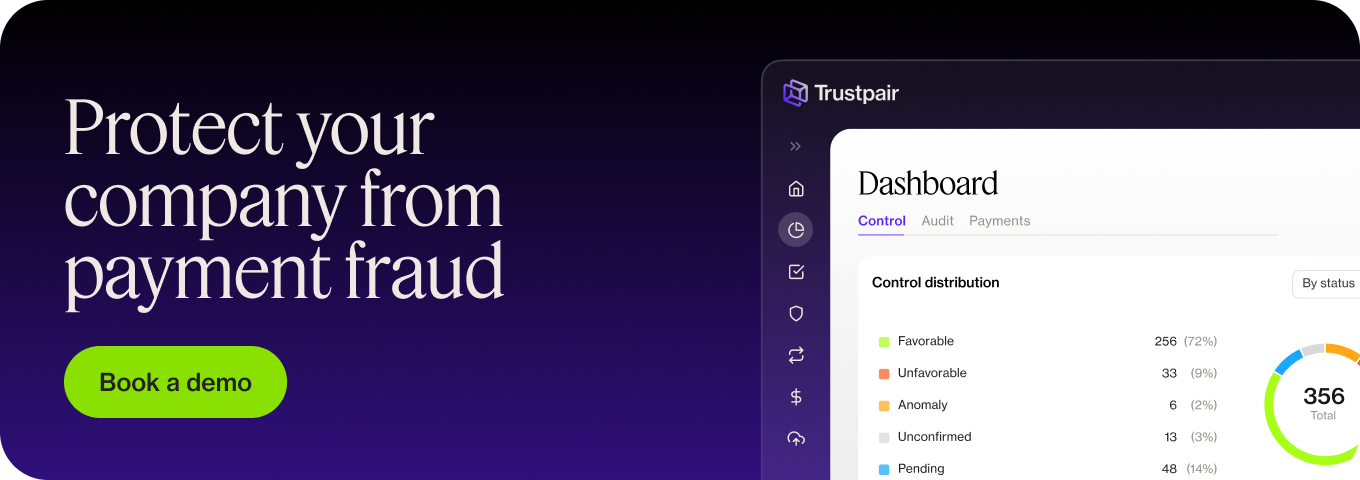Reducing risks to a minimum is every company’s dream. Accidents, mistakes, or fraudulent acts have no place in businesses. This is true when it comes to protection at work, or protecting company sites from unauthorized access by third parties for example. While specific rules and measures can be implemented for these rather tangible aspects, it’s more difficult to guarantee the quality of financial systems or processes. To answer these less tangible threats, many companies set up an internal control system. Discover some examples of preventive, corrective, and detective controls in this article.
To protect your company from unwanted third-party fraud, contact an expert from Trustpair, the ultimate fraud prevention solution.
What is internal control?
Internal control is a method of evaluation carried out (in general) by an enterprise’s internal audit department, to ensure that processes are properly implemented and to identify potential risks. We can also talk about a security system, consisting of means and resources adapted to the company, whose various objectives are:
- Make optimal use of company resources;
- Control his activities;
- Make all of its operations more efficient;
- Identify risks (financial, operational, compliance, or security) that may compromise the achievement of its objectives.
Logically, the larger the company, the more consistent the internal control processes. In addition, internal control concerns all the company’s staff, not just the managers. On the other hand, it is up to the management of the enterprise to define and monitor internal control processes according to the activity of the enterprise.
Role and principles of an internal control system
The goal of having an internal control system in place is to have procedures that ensure the protection of corporate assets. To achieve this goal, management uses key principles. Fundamental principles of internal control include:
- Keeping records
- Securing assets with key employees
- Segregation of duties
- Mandatory employee rotation
- Sharing the responsibility of third parties
- Sharing the responsibility of payments
- Using technology controls
- Conducting regular independent assessments
The topic of internal controls is constantly expanding, and this non-exhaustive list of principles is likely to expand in the future as well.
The 3 Types of internal controls
Controls can be preventive, deterring fraud and error, or detective, identifying problems when they occur. By working together, these two types of policies can optimize business activities by solving existing problems and preventing future problems. Corrective controls are the third type of policy: they come into play if mistakes are detected.
An integral part of the control activity is the segregation of duties – sometimes called the four-eyes principle. Segregation of duties makes sure important tasks aren’t handled by one staff member only but by different employees. This will help avoid mistakes or internal fraud risks.
Preventive Internal Control
Preventive control operations include detailed documentation and authorization standards. Their main purpose is to prevent errors or frauds from happening in the first place. A fundamental element of this process is the separation of duties. This ensures that no one can authorize, record, and have custody of a financial transaction and the resulting assets. Authorizing invoices, verifying expenses, and limiting physical access to equipment, inventory, cash, and other assets are preventive and detective control examples.
Internal detective control
Detection control refers to a type of internal control designed to detect problems in a company’s processes once they have occurred. Detection controls can be used for many different purposes, such as quality control, fraud prevention, and legal compliance. Preventive and detective control examples: physical inventory, which can be used to detect when actual inventories do not match those in accounting records.
In small businesses, internal controls can often be implemented simply through management oversight. In large companies, however, a more elaborate system of internal audits and other formal guarantees is often necessary.
Other examples of preventive controls and detective controls include identifying causes of irregularities and modifying the treatment method to minimize future occurrences.
Corrective Internal Control
Designed to ensure that appropriate measures are taken to reverse the effect of adverse events or to avoid their replication in the future. This control assumes that the detective control has worked well. Thus, the corrective controls aim to correct detected errors or reduce their impacts.
SaaS Solutions to Support Internal Control
Internal control is the first barrier to identifying risks, setting up adapted processes to secure the actions performed by the finance teams, or taking preventive measures.
Trustpair’s third-party risk management platform specializes in B2B payment fraud prevention and secures the entire Procure-to-Pay process, from the addition or editing of a third party to the final payment. This includes real-time data monitoring of the data in the vendor master file to make sure there isn’t any suspicious data change or transaction. It’s the ultimate fraud protection method.
To learn more about implementing the right fraud prevention solution for your business, download the Ultimate Fraud Guidebook!


